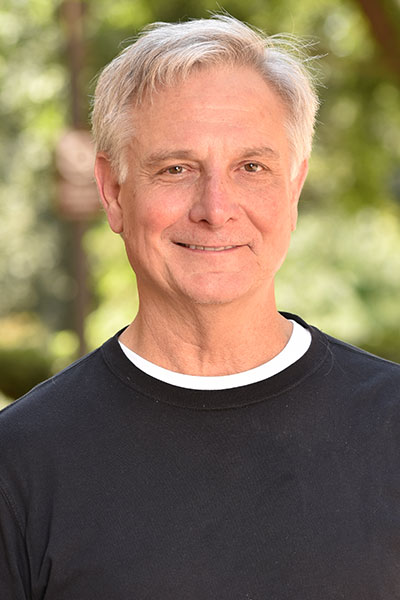James G. Tidball
Distinguished Professor

Office: 1135 TLSB
Phone: (310) 206-3395
Biography
My interest in biological research was solidified by my undergraduate experience at Duke University in the Department of Zoology, where I was a student research assistant with Professor Steve Wainwright. Through that experience, I became fascinated with the question of how organisms detect and respond to changes in their mechanical environment. I pursued that question as a Ph.D. student in the lab of Professor David Chapman at Dalhousie University in Halifax, Nova Scotia, where I tried to learn how corals detect the direction of water movement. I then returned to Duke University as a post-doctoral fellow, to further study interactions between cells and the mechanical environment, focusing on the molecular structure of myotendinous junctions (MTJs) where forces generated by muscles are transferred to the extracellular matrix.
Shortly after we initiated those studies of the MTJ, the defective gene product that causes the lethal muscle wasting disease called Duchenne muscular dystrophy (DMD) was discovered by Dr. Lou Kunkel and Eric Hoffman. The missing protein in the disease is a membrane-associated, structural protein called dystrophin, forming the basis for the belief that the disease was caused by a mechanical defect in the muscle cell membrane. My lab then discovered that dystrophin was highly-concentrated at MTJs, but we saw that many features of the disease did not support the idea that DMD was primarily caused by a mechanical defect in the cell membrane. That realization set us on a path to identify the primary cause of muscle cell death in DMD, eventually leading to our discovery that an immune response to the mutant muscle cells was the source of most muscle damage in the disease. Since that finding, we have continued to fully-delineate the role of the immune system in muscular dystrophy, and have built on those findings in pre-clinical studies aimed at manipulating the immune response to reduce the pathology of muscular dystrophy.
Research Interests
Research in the Tidball lab is directed toward understanding processes that regulate skeletal muscle wasting and regeneration. Exploring the mechanisms through which the immune system can modulate skeletal muscle wasting, injury, regeneration and growth is a particular focus of the lab. Discoveries in the our lab over the past 25 years have shown that immune cells, especially myeloid cells, play a major role in modulating muscle injury and repair that occur in chronic, muscle wasting diseases and following acute injuries. For example, our findings have shown that macrophages and eosinophils are key effector cells in the pathogenesis of Duchenne muscular dystrophy. Ongoing investigations in the lab are revealing the identity of specific molecules released by myeloid cells that promote muscular dystrophy. However, discoveries in our lab have also shown that regulatory interactions between cytotoxic, M1 macrophages in dystrophic muscle and anti-inflammatory, M2 macrophages are important in regulating the balance between the death of dystrophic muscle and regenerative processes. This work showed that the experimental manipulation of the balance between the functions of M1 and M2 macrophages can affect the severity of muscular dystrophy, suggesting that manipulation of macrophage phenotype in vivo may have potential therapeutic value for the treatment of the disease. We are now building on those findings in an NIH-funded preclinical investigation in which we are testing whether pharmacological manipulations of co-stimulatory signals that macrophages provide to T-lymphocytes can attenuate the pathology of muscular dystrophy.
Other NIH-funded investigations in our lab explore epigenetic mechanisms through which an anti-aging protein called Klotho affects myogenesis and muscle regeneration in neonatal and aging muscle. We are also determining how those Klotho-driven epigenetic regulatory influences affect muscle growth following acute muscle injury or exercise.
Education
B.S., Duke University 1975
Ph.D., Dalhousie University 1981
Selected Publications
Welc, S.S., Flores, I., Wehling-Henricks, M. Ramos, J. Wang, Y. Bertoni, C. and J. G. Tidball., “Targeting a therapeutic LIF transgene to muscle via the immune system ameliorates muscular dystrophy”, Nature Communications, 10 : 1-17 (2019) .
Wang, Y, M. Wehling-Henricks, S.S. Welc, A.L. Fisher, Q. Zuo and J.G. Tidball., “Aging of the immune system causes reductions in muscle stem cell populations, promotes their shift to a fibrogenic phenotype, and modulates sarcopenia”, FASEB J, 33 (1): 1414-1427 (2019) .
Wang, Y., S.S. Welc, M. Wehling-Henricks and J.G. Tidball., “Myeloid cell-derived tumor necrosis factor-alpha promotes sarcopenia and regulates muscle cell fusion with aging muscle fibers”, Aging Cell, 17 : e12828- (2018) .
Tidball, J.G., Welc, S. and Wehling-Henricks, M., “The immunobiology of inherited muscular dystrophies”, Comprehensive Physiology, 8 : 1313-1356 (2018) .
Wehling-Henricks, M, Welc, S., Samengo, G., Rinaldi, C., Lindsey, C., Wang, Y., Lee, J., Kuro-o, M. and J. G. Tidball., “Macrophages escape Klotho gene silencing in the mdx mouse model of Duchenne muscular dystrophy and promote muscle growth and increase satellite cell numbers through a Klotho-mediated pathway”, Human Molecular Genetics, 27 : 14-29 (2018) .
Tidball, J.G., “Regulation of muscle growth and regeneration by the immune system”, Nature Reviews Immunology, 17 : 165-178 (2017) .
Wehling-Henricks, M., Li, Z., Lindsey, C., Wang, Y., Welc, S.S., Ramos, J.N., Khanlou, N., Kuro-O, M., Tidball, J.G., “Klotho gene silencing promotes pathology in the mdx mouse model of Duchenne muscular dystrophy”, Human Molecular Genetics, 1-18 (2016) .
Wang, Y., Wehling-Henricks, M., Samengo, G. and J.G. Tidball, “Increases of M2a macrophages and fibrosis in aging muscle are influenced by bone marrow aging and negatively regulated by muscle-derived nitric oxide”, Aging Cell, 14 : 678-688 (2015) .
Tidball, J.G. and M. Wehling-Henricks, “Shifts in macrophage cytokine production drive muscle fibrosis”, Nature Medicine, 21 : 665-666 (2015) .
Wang Y, Wehling-Henricks M, Samengo G, Tidball JG “Increases of M2a macrophages and fibrosis in aging muscle are influenced by bone marrow aging and negatively regulated by muscle-derived nitric oxide.” Aging Cell, 14 (4): 678-88 (2015).

612 Charles E. Young Drive East
Box 957246
Los Angeles, CA 90095-7246
(t) (310) 825-4373
(f) (310) 206-9184

